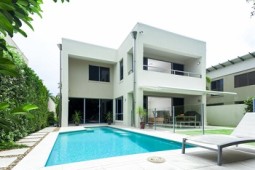 Having your own swimming pool at home can be great for a variety of different reasons. It can be a source of recreation, relaxation, therapy or exercise and could even add some value to your home should you ever choose to sell up. And you don’t need to be a multi-millionaire to have your own slice of luxury either; if you stick to a budget then there’s no reason why your new swimming pool has to break the bank.
Having your own swimming pool at home can be great for a variety of different reasons. It can be a source of recreation, relaxation, therapy or exercise and could even add some value to your home should you ever choose to sell up. And you don’t need to be a multi-millionaire to have your own slice of luxury either; if you stick to a budget then there’s no reason why your new swimming pool has to break the bank.
However, there are a few considerations needed before you go jumping in at the deep end, literally.
Make Sure You’re Aware Of The Full Cost –
You may have budgeted well for the physical construction of the swimming pool but have you factored in the cost of everything else that is required? Filters, heaters, covers and on-going chemical supplies will all need to be acquired somehow so it’s important that you know the full cost of your project before you start the build. You should also check with your home insurance provider to see if you are covered for owning a swimming pool. If not then it could cost you more to extend your policy.
Decide Upon The Practicalities –
Designing your own swimming pool may seem easy in theory but there are certain practical elements that need to be decided upon. For example what size and shape do you want it to be and do you have the space to incorporate these dimensions? You also need to consider the climate which you live in. This will determine whether the pool needs to be undercover, indoors, heated or equipped with a removable top that helps to keep the leaves and debris out when it gets windy.
It’s also important to think about what materials you want your pool to be made from. Options include tiles, fibreglass, vinyl and this will affect the style and look of your pool as well as how easy it is to maintain.
Safety Should Be A Priority –
When planning your pool, there is a need to put safety first; especially if you have young children. This could include installing alarm systems that are triggered when somebody falls into the water or having a child-secure gate that has to be passed through in order to gain access to the pool. One of the best ways to make sure your pool is safe though is by incorporating sufficient safety surfacing around the edge of it.
Similar solutions are used in public leisure facilities and they help to give people with bare feet a better grip in wet conditions. These rubber tiles will help to stop people slipping over and hurting themselves as well as cushioning their fall is an accident does occur.
Check Whether Permission Is Required –
As usual with any building work that you carry out in the grounds of your home, it’s always best to double check whether you need planning permission or not. With swimming pools, as long as they cover less than 50% of the area of your garden, this should not be necessary. However, it is always best to consult the relevant authorities first to ensure you don’t get yourself into any hot water (until the pool is built, of course).
Featured images:
- License: Royalty Free or iStock source: Shutterstock
By Chris Mayhew
Chris Mayhew enjoyed spending time in his auntie’s swimming pool when he was younger and would love to have one in his own home. He would recommend safety surfacing solutions from Smith Brothers to anyone thinking of building their own swimming pool at home.
